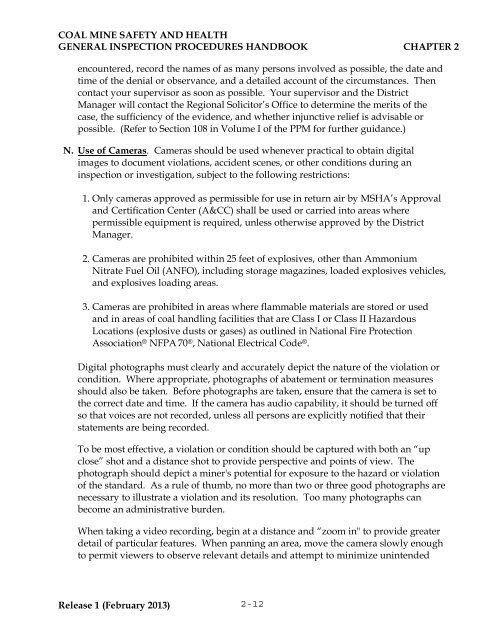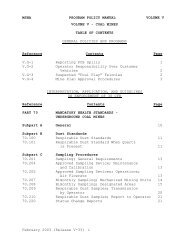MSHA HANDBOOK SERIES - PH13-V-1 - Mine Safety and Health ...
MSHA HANDBOOK SERIES - PH13-V-1 - Mine Safety and Health ...
MSHA HANDBOOK SERIES - PH13-V-1 - Mine Safety and Health ...
Create successful ePaper yourself
Turn your PDF publications into a flip-book with our unique Google optimized e-Paper software.
COAL MINE SAFETY AND HEALTH<br />
GENERAL INSPECTION PROCEDURES <strong>HANDBOOK</strong> CHAPTER 2<br />
encountered, record the names of as many persons involved as possible, the date <strong>and</strong><br />
time of the denial or observance, <strong>and</strong> a detailed account of the circumstances. Then<br />
contact your supervisor as soon as possible. Your supervisor <strong>and</strong> the District<br />
Manager will contact the Regional Solicitor’s Office to determine the merits of the<br />
case, the sufficiency of the evidence, <strong>and</strong> whether injunctive relief is advisable or<br />
possible. (Refer to Section 108 in Volume I of the PPM for further guidance.)<br />
N. Use of Cameras. Cameras should be used whenever practical to obtain digital<br />
images to document violations, accident scenes, or other conditions during an<br />
inspection or investigation, subject to the following restrictions:<br />
1. Only cameras approved as permissible for use in return air by <strong>MSHA</strong>’s Approval<br />
<strong>and</strong> Certification Center (A&CC) shall be used or carried into areas where<br />
permissible equipment is required, unless otherwise approved by the District<br />
Manager.<br />
2. Cameras are prohibited within 25 feet of explosives, other than Ammonium<br />
Nitrate Fuel Oil (ANFO), including storage magazines, loaded explosives vehicles,<br />
<strong>and</strong> explosives loading areas.<br />
3. Cameras are prohibited in areas where flammable materials are stored or used<br />
<strong>and</strong> in areas of coal h<strong>and</strong>ling facilities that are Class I or Class II Hazardous<br />
Locations (explosive dusts or gases) as outlined in National Fire Protection<br />
Association ® NFPA 70 ® , National Electrical Code ® .<br />
Digital photographs must clearly <strong>and</strong> accurately depict the nature of the violation or<br />
condition. Where appropriate, photographs of abatement or termination measures<br />
should also be taken. Before photographs are taken, ensure that the camera is set to<br />
the correct date <strong>and</strong> time. If the camera has audio capability, it should be turned off<br />
so that voices are not recorded, unless all persons are explicitly notified that their<br />
statements are being recorded.<br />
To be most effective, a violation or condition should be captured with both an “up<br />
close” shot <strong>and</strong> a distance shot to provide perspective <strong>and</strong> points of view. The<br />
photograph should depict a miner's potential for exposure to the hazard or violation<br />
of the st<strong>and</strong>ard. As a rule of thumb, no more than two or three good photographs are<br />
necessary to illustrate a violation <strong>and</strong> its resolution. Too many photographs can<br />
become an administrative burden.<br />
When taking a video recording, begin at a distance <strong>and</strong> “zoom in" to provide greater<br />
detail of particular features. When panning an area, move the camera slowly enough<br />
to permit viewers to observe relevant details <strong>and</strong> attempt to minimize unintended<br />
Release 1 (February 2013) 2-12
















